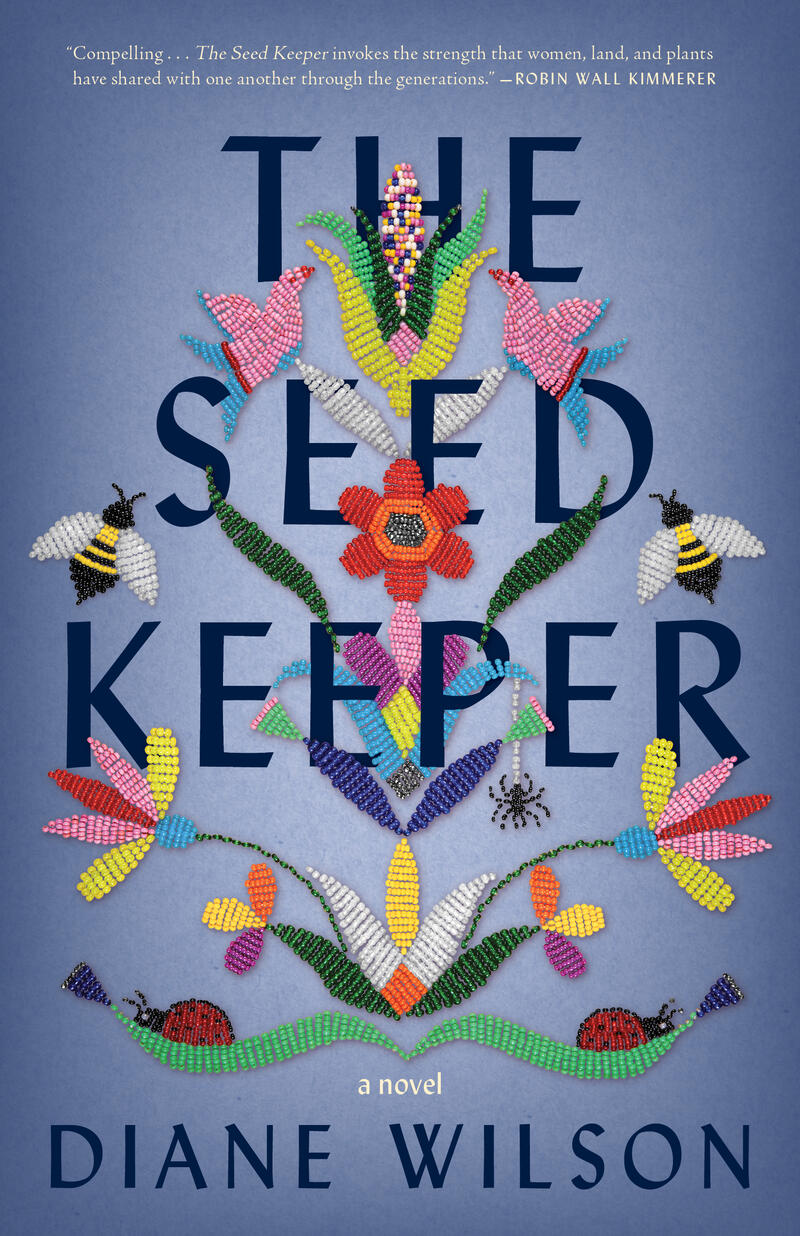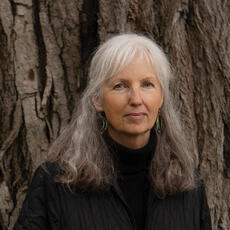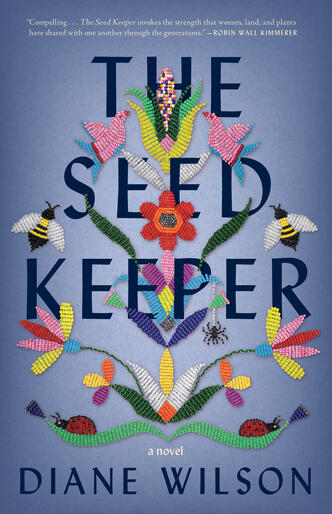How Seeds Hold Stories: A Cover Image Story

Haŋ (hello) friends, Kachina Yeager here! I’m a fellow at Milkweed, and I’m so very pleased that this interview is my first blog feature. Our team is so excited to share the cover of Diane Wilson’s forthcoming novel, The Seed Keeper—out March 2021— with you. This incredible cover features custom beadwork by Standing Rock Dakota artist, Holly Young. I had the delightful opportunity to discuss this work with Diane Wilson, and to now be sharing this conversation with all of you!
The Seed Keeper follows three generations of Dakota women, their lives and struggles, and the seeds that bind them together. Honest and transformative, The Seed Keeper weaves a compelling story that asks us to contemplate interconnection and kinship.
Kachina Yeager: I love the way that the cover brings together two forms of art that feel like the continuation of specifically Dakota legacies: keeping seeds and Dakota floral beadwork (by the amazing Holly Young!). Interestingly, the type of beads are actually called seed beads, which is a small connection that I absolutely love. Could you talk a bit about how this cover captures the stories within the pages?
Diane Wilson: At its heart, this novel is a tribute and a prayer and a gesture of gratitude to the seeds that have sustained indigenous communities for thousands of years. Even beyond that, seeds are fundamental to the complex web of relationships that connect a cycle of life on this earth, from plants to animals to human beings. Holly Young’s exquisite beadwork captures this interweaving of relationships, and the reciprocity that is essential to maintaining a fragile balance between relatives. Despite the trauma of the past several hundred years, this tender connection to the earth is still central to our identity as indigenous people. Holly’s artwork, and the stories in the novel, remind us that reconnecting with the beauty and the joy of our precious seeds is healing, and a pathway to cultural recovery. I feel so blessed to have Holly’s beadwork on the cover!
KY: The title of your novel is also a moniker you yourself hold. Could you tell us a bit about your own journey in being a seed keeper, and how this practice has influenced your relationship to writing?
DW: I often describe myself as a writer and a gardener as those two interests have pretty much dictated the course of my life. I first learned about seeds in 2000, when I was working on a memoir titled Spirit Car: Journey to a Dakota Past, that traces my Dakota family back to the 1862 U.S.-Dakota War. A tiny garden in Farmington was growing a collection of old, tribal seeds that included corn that had been carried on the Cherokee Trail of Tears, Hopi Black Turtle Beans, and tobacco that was said to be more than 800 years old. I was immediately drawn to learn more about these seeds and began to volunteer with Dream of Wild Health, a local Native nonprofit organization. As a writer, I’m fascinated with the idea that we are surrounded by untold, wordless stories carried by these seeds. It raised an interesting question about how we, as human beings, might learn a new way to listen by observing what plants and animals are sharing with us.
KY: One of the major themes of this novel is the idea of seeds as knowledge holders, as story keepers. I’m interested to hear about what the process of writing a story centering seeds as almost an entity of their own with their own knowledge and lessons was like for you?
DW: I think one of the reasons why I fell in love with the seeds was because they hold stories of countless generations, the families that have grown and shared them as food. These seeds contain a living record of their seasons on the land, how much rain fell, how hard the wind blew. The imprint of the hands that planted them. Throughout history, seeds have adapted and survived, which helped the families who grew them to also survive. I began to understand nature’s brilliance in finding a way to perpetuate life in a tiny, fragile seed, each one with its own unique abilities that have adapted to the natural laws of the environment they live in. And yet, so many of our seeds have disappeared, along with their stories. By acknowledging them as independent living beings, my hope was that sharing their story would remind us of the importance of reclaiming our original relationship. Growing seeds and sharing food is joyful work that brings people together, across communities. Working with seeds changed my life; this novel is a way for me to return the gift.
KY: Something that I really love about The Seed Keeper is the way you weave together multiple generations of a Dakota family’s story. It seems to me that through these generations and through time, there is a lot of healing and reclamation that happens along the way. Can you talk about the story you heard while you were participating in the Dakota Commemorative March, and how that led you to crafting this multi-generational story? Why was it important to you to show these experiences across time?
DW: While writing my family’s story in a memoir, I learned how important it was to see the way assimilation worked across generations, often handed down as an invisible legacy. The trauma of boarding schools, for example, can move between generations while the actual memories are silenced or repressed. And yet, because of prayer, generations have found ways to survive by protecting what is most important to our communities, hiding ceremonies and speaking the language in secret. That’s why families often hung onto a handful of seeds even when they no longer knew how to grow them.
Shortly after I began working with the seeds, I heard about the Dakota Commemorative March in 2002. This event was a 150-mile walk to honor the 1700 Dakota women, children and elders who were force-marched from the Lower Sioux reservation to a concentration camp at Fort Snelling after the 1862 U.S.-Dakota War. This was the first time this history had been acknowledged. The week-long November march was a grueling, painful, beautiful, healing experience. I had a conversation with one of the marchers who shared the story about the Dakota women who hid their seeds in the hems of their skirts, in their pockets, not knowing where they were being sent. They protected those seeds even when families were starving, which is why we have Dakota corn to grow today. That story really touched my heart and helped me realize how strong these women had to be to ensure the survival of the people. As we face new challenges today, such as genetically modified seeds, it’s our responsibility to be as strong as our ancestors in protecting these seeds for future generations.
Through my work and my writing, I’ve learned that it’s healing to know the history and stories of where we come from. Despite the loss and the trauma, we need to remember the strength of our ancestors, their courage, their prayers for future generations, and their determination to survive. That kind of strength comes from a great, selfless love that is at the heart of indigenous communities. As we say in Dakota, Mitakuye Owasin. We Are All Related. As I grow this Dakota corn in my own garden, I feel the love of my ancestors, as well as my responsibility to share these seeds and their stories.

